
Corals are marine invertebrates within the class Anthozoa of the phylum Cnidaria. They typically form compact colonies of many identical individual polyps. Coral species include the important reef builders that inhabit tropical oceans and secrete calcium carbonate to form a hard skeleton.
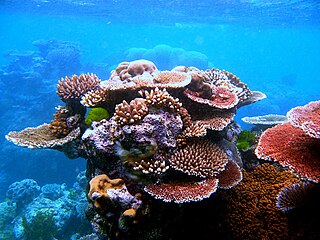
Anthozoa is a class of marine invertebrates which includes the sea anemones, stony corals and soft corals. Adult anthozoans are almost all attached to the seabed, while their larvae can disperse as part of the plankton. The basic unit of the adult is the polyp; this consists of a cylindrical column topped by a disc with a central mouth surrounded by tentacles. Sea anemones are mostly solitary, but the majority of corals are colonial, being formed by the budding of new polyps from an original, founding individual. Colonies are strengthened by calcium carbonate and other materials and take various massive, plate-like, bushy or leafy forms.

Antipatharians, also known as black corals or thorn corals, are an order of soft deep-water corals. These corals can be recognized by their jet-black or dark brown chitin skeletons, surrounded by the polyps. Antipatharians are a cosmopolitan order, existing at nearly every location and depth, with the sole exception of brackish waters. However, they are most frequently found on continental slopes under 50 m (164 ft) deep. A black coral reproduces both sexually and asexually throughout its lifetime. Many black corals provide housing, shelter, food, and protection for other animals.
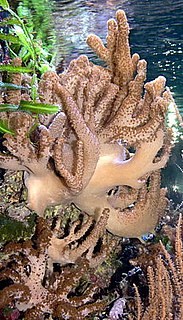
Alcyonacea, or soft corals, are an order of corals. In addition to the fleshy soft corals, the order Alcyonacea now contains all species previously known as "gorgonian corals", that produce a more or less hard skeleton, though quite different from "true" corals (Scleractinia). These can be found in suborders Holaxonia, Scleraxonia, and Stolonifera. They are sessile colonial cnidarians that are found throughout the oceans of the world, especially in the deep sea, polar waters, tropics and subtropics. Common names for subsets of this order are sea fans and sea whips; others are similar to the sea pens of related order Pennatulacea. Individual tiny polyps form colonies that are normally erect, flattened, branching, and reminiscent of a fan. Others may be whiplike, bushy, or even encrusting. A colony can be several feet high and across, but only a few inches thick. They may be brightly coloured, often purple, red, or yellow. Photosynthetic gorgonians can be successfully kept in captive aquaria.
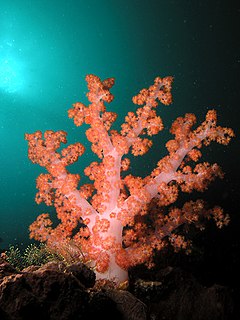
Octocorallia is a subclass of Anthozoa comprising around 3,000 species of water-based organisms formed of colonial polyps with 8-fold symmetry. It includes the blue coral, soft corals, sea pens, and gorgonians within three orders: Alcyonacea, Helioporacea, and Pennatulacea. These organisms have an internal skeleton secreted by mesoglea and polyps with eight tentacles and eight mesentaries. As with all Cnidarians these organisms have a complex life cycle including a motile phase when they are considered plankton and later characteristic sessile phase.
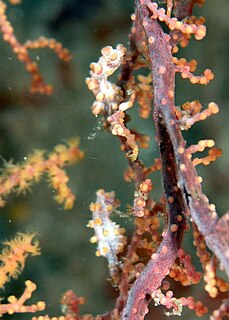
The pygmy seahorses comprise several species of tiny seahorse in the syngnathid family or Syngnathidae. Family Syngnathidae is part of order Syngnathiformes, which contains fishes with fused jaws that suck food into tubular mouths. They are found in Southeast Asia in the Coral Triangle area. They are some of the smallest seahorse species in the world, typically measuring less than 2 centimetres (0.79 in) in height.
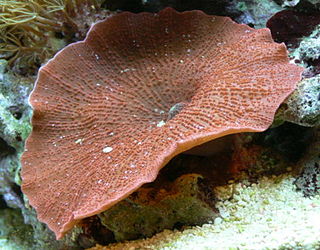
Corallimorpharia is an order of marine cnidarians closely related to stony or reef building corals (Scleractinia). They occur in both temperate and tropical climates, although they are mostly tropical. Temperate forms tend to be very robust, with wide and long columns, whereas tropical forms tend to have very short columns with a wide oral disc and very short tentacles. The tentacles are usually arranged in rows radiating from the mouth. Many species occur together in large groups, although there are recorded instances of individuals. In many respects, they resemble the stony corals, except for the absence of a stony skeleton. Morphological and molecular evidence suggests that they are very closely related to stony corals.

Tritoniopsis elegans is a species of dendronotid nudibranch. It is a marine gastropod mollusc in the family Tritoniidae and is found in the western Indo-Pacific. It was first described by the French naturalist Jean Victoire Audouin in 1826, the type specimen being found in the Red Sea.
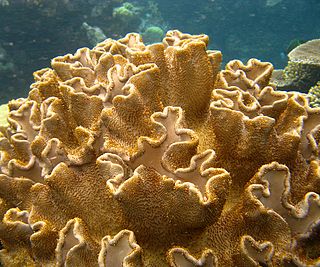
Alcyoniidae is a family of leathery or soft corals in the phylum Cnidaria.

The roving coral grouper, also known as the spotted coral grouper, is a species of marine ray-finned fish, a grouper from the subfamily Epinephelinae which is part of the family Serranidae, which also includes the anthias and sea basses. It is found in the Indo-Pacific, although the Red Sea taxon, P.. marisrubri, is regarded as a separate species by some authorities.

Carl Benjamin Klunzinger was a German physician and zoologist.
Lobularia is a genus of soft corals in the family Alcyoniidae.
Cladiella krempfi is a species of soft coral in the family Alcyoniidae. It is found in the western Indo-Pacific and was first described by the British zoologist Sydney John Hickson in 1919.

Cladiella is a genus of soft corals native to the Indo-Pacific region. These corals are commonly known as colt corals or finger leather corals and are often kept in reef aquaria. They grow fast, have short rounded or conical lobes and are sticky to the touch owing to the production of much mucus. They are creamy or pale grey in colour. The polyps are fully retractable and give the colony a fluffy look when extended. They may be a contrasting green or brown hue.
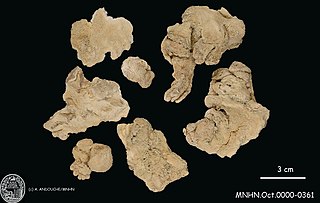
Cladiella australis is a species of soft coral in the family Alcyoniidae. It is found in the western Indo-Pacific. It is commonly known as the finger blanching soft coral because with the polyps extended it appears brown but when poked with a finger, the polyps retract into the leathery base tissue and the coral appears white.
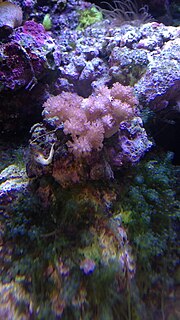
Klyxum is a genus of animals in the family Alcyoniidae. They are commonly called cauliflower colt coral, or simply colt coral. These common names can also refer to the related genus Cladiella.
C. elegantissima may refer to:

Elphinstone Reef is a standalone reef in the Egyptian Red Sea situated about 30 kilometers north from the town of Marsa Alam in Egypt. The coral community in this reef is primarily composed of soft corals such as Dendronephthya species.
Finger leather coral may refer to different coral taxa:














